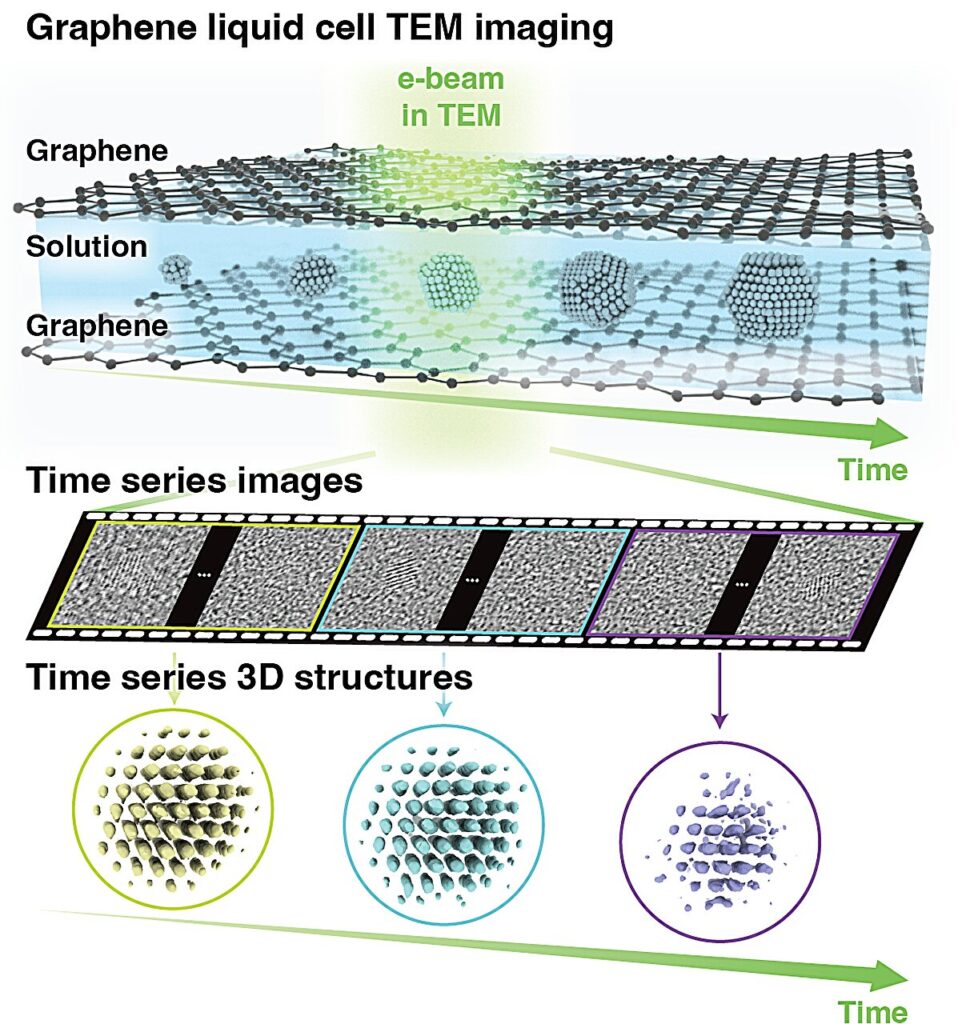A research team from Seoul National University College of Engineering has developed a technology to observe atomic structural changes of nanoparticles in three dimensions. Their study, which resolves a long-standing challenge even past Nobel laureates could not solve, was published online in Nature Communications on January 29.
Recently, nanoparticles have garnered significant attention as they are widely used in developing functional materials for cutting-edge industries such as energy, environment, and medicine. Due to their nanoscale size—measuring just a few nanometers—nanoparticles exhibit unique physical and chemical properties. Their reactivity varies significantly with size, making it crucial to observe structural changes.
However, existing techniques for analyzing nanostructures have limitations. They are often restricted to fixed nanoparticles under vacuum conditions or provide only averaged information from multiple nanoparticles, limiting observations to simple structural identification. As a result, directly observing the three-dimensional atomic structure of individual nanoparticles over time in liquid environments remains a formidable technical challenge.
Unlike nanoparticles, the three-dimensional atomic structures of proteins have already been elucidated. This breakthrough was made possible by the revolutionary cryo-transmission electron microscopy (cryo-TEM) technique developed by three scientists who won the 2017 Nobel Prize in Chemistry.
Building on this innovation, Professor Jungwon Park’s research team further advanced the field by developing a ‘liquid transmission electron microscopy (liquid TEM)’ technique using graphene, allowing three-dimensional visualization of nanostructures in solution. The research team’s previous study on this technique, called Brownian tomography, was featured on the cover of Science in 2020.
Continuing this trajectory, Professor Park’s team has now developed the time-resolved Brownian tomography technique, enabling real-time tracking of three-dimensional atomic structural changes in individual nanoparticles. This advancement opens new avenues for a deeper understanding of atomic-level changes in nanoparticles during complex chemical reactions. Particularly significant is that this research, supported by Samsung’s Future Technology Development Program—an initiative that funds pioneering research tackling scientific grand challenges—has successfully addressed a previously unsolvable problem.
The research team developed a method to observe freely moving nanoparticles in solution by leveraging the graphene liquid cell transmission electron microscopy (Graphene Liquid Cell TEM) technique. This method involves capturing nanoparticles undergoing Brownian motion (random movement of microscopic particles in fluid) from multiple angles over time and reconstructing the collected data into a three-dimensional visualization.
Unlike conventional TEM, which typically examines fixed nanoparticles in vacuum conditions, or spectroscopic methods that only provide averaged information from numerous nanoparticles, this breakthrough represents a significant leap forward. It is the first-ever technology capable of directly measuring the three-dimensional atomic arrangement of a single nanoparticle as it dynamically changes in a liquid environment.
Furthermore, using the newly developed technique, the research team conducted an in-depth study on the structural changes of platinum (Pt) nanoparticles at the atomic level during the etching (chemical corrosion) process. They successfully captured the precise moments when surface atoms detached (desorbed), rearranged, or reattached (re-adsorbed) in three dimensions.
Additionally, they discovered that when the nanocrystals shrank to around 1 nm in size, a highly disordered phase emerged—an unexpected finding since platinum generally exhibits a highly ordered atomic structure. This study suggests that extremely small nanoparticles may exhibit unique structural characteristics distinct from their larger counterparts, even when composed of the same elemental material.

Additionally, the time-resolved Brownian tomography technique is regarded as a transformative advancement in atomic structure observation, surpassing conventional ‘transmission electron microscopy’ (TEM) and cryo-TEM, the latter of which was crucial in winning the 2017 Nobel Prize in Chemistry. This innovation allows researchers to analyze how nanomaterials’ three-dimensional structures evolve over time under various chemical conditions such as applied voltage or reactive solution composition.
The study’s findings are expected to provide a more precise understanding of structural changes affecting the performance of next-generation nanomaterials, including metals, semiconductors, and oxides. Moreover, this research successfully observed structural changes in platinum nanoparticles—critical catalysts for eco-friendly hydrogen energy applications—laying the groundwork for future high-performance catalyst development.
Professor Park emphasized, “The development of time-resolved Brownian tomography continues the legacy of the 2017 Nobel Prize-winning cryo-TEM and our 2020 Science cover-featured liquid TEM innovation. This new technique will significantly contribute to unraveling complex reaction mechanisms in hydrogen fuel cells, CO₂ conversion catalysts, lithium-ion batteries, and other advanced energy materials, facilitating the design of superior materials.”
The paper’s lead author, Sungsu Kang, remarked, “Our research directly captured real-time atomic-level structural changes of nanocrystals in liquid environments. This achievement is particularly significant because it successfully visualized surface atomic movements and the emergence of new phases unique to nanomaterials—phenomena that were challenging to detect using conventional spectroscopic or electrochemical methods.”


